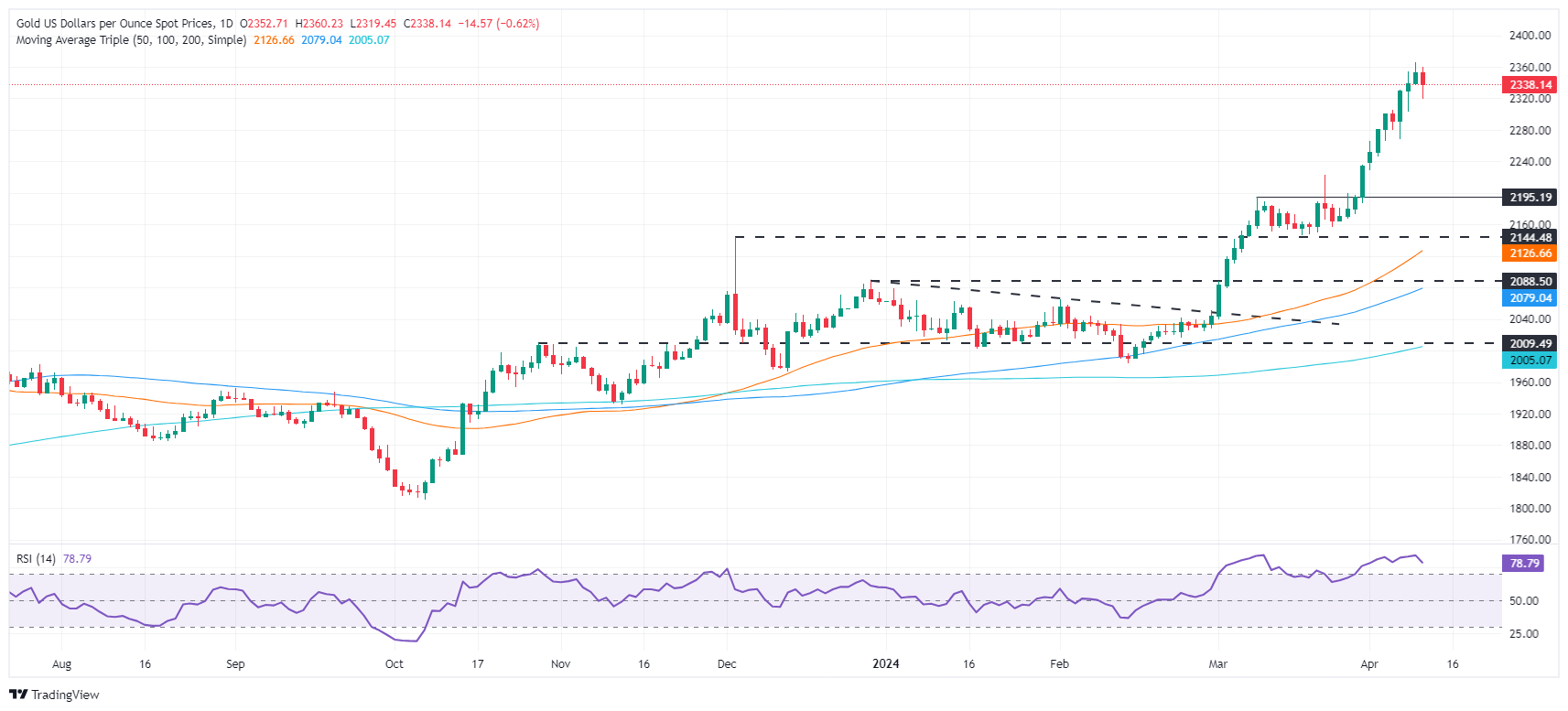Gold price fall as high US CPI data tempers Fed cut expectation

- Gold drops as US inflation data complicates Fed rate cut intentions.
- Investors rethink Fed’s monetary approach amid persistent inflation as they now expect two rate cuts in 2024.
- US real yields rise above 2%, challenging Gold post-CPI release.
Gold price is on the defensive on Wednesday following the release of March inflation figures in the United States (US). The figures witnessed an uptick in monthly and annual readings and might dent the Federal Reserve’s (Fed) intentions of easing policy. Following the data release, US Treasury yields rose, the Greenback climbed, and US real yields overcame the 2% threshold, a headwind for the precious metal.
XAU/USD spot trades at $2,336 after losing 0.66% following the US Consumer Price Index (CPI) release. The US Bureau of Labor Statistics (BLS) announced that March’s CPI was hotter than expected, though unchanged in three of the four inflation readings compared to February’s data. Meanwhile, headline inflation jumped above the annual forecast and the prior month’s reading.
Daily digest market movers: Gold loses its shine after hot US CPI report
- US Consumer Price Index (CPI) increased 0.4% monthly and 3.5% annually, surpassing expectations and marking an uptick from the previous month’s figures.
- Core CPI, which excludes food and energy, also exceeded forecasts, remaining steady at 0.4% MoM and 3.8% YoY, mirroring February’s data.
- Following this, US Treasury bond yields experienced a significant surge, particularly at the short end, with the 2-year Treasury note yield jumping by 20 basis points.
- The US Dollar Index (DXY) also witnessed a substantial increase, soaring over 1% to reach new YTD high of 105.27.
- Data from the Chicago Board of Trade (CBOT) suggests that futures traders expect just two cuts to the fed funds rate as they project the main reference rate to end the year at 4.98%.
- World Gold Consortium reveals that the People’s Bank of China was the largest buyer of the yellow metal in February, increasing its reserves by 12 tonnes to 2,257 tonnes.
Technical analysis: Gold’s advance stalls, prices tumble below $2,350
Gold’s retreat from all-time highs opened the door to form an Evening Star candlestick pattern. However, XAU/USD must close below the April 8 open of $2,329, which would pave the way for a deeper correction.
The XAU/USD first support would be the April 8 daily low of $2,303. Once surpassed, that could put downward pressure on the yellow metal and drive it to March’s 21-session high of $2,222. Further losses are seen at $2,200.
On the other hand, if XAU/USD resumes its rally, buyers are eyeing the $2,350 mark, followed by $2,400.
Fed FAQs
Monetary policy in the US is shaped by the Federal Reserve (Fed). The Fed has two mandates: to achieve price stability and foster full employment. Its primary tool to achieve these goals is by adjusting interest rates. When prices are rising too quickly and inflation is above the Fed’s 2% target, it raises interest rates, increasing borrowing costs throughout the economy. This results in a stronger US Dollar (USD) as it makes the US a more attractive place for international investors to park their money. When inflation falls below 2% or the Unemployment Rate is too high, the Fed may lower interest rates to encourage borrowing, which weighs on the Greenback.
The Federal Reserve (Fed) holds eight policy meetings a year, where the Federal Open Market Committee (FOMC) assesses economic conditions and makes monetary policy decisions. The FOMC is attended by twelve Fed officials – the seven members of the Board of Governors, the president of the Federal Reserve Bank of New York, and four of the remaining eleven regional Reserve Bank presidents, who serve one-year terms on a rotating basis.
In extreme situations, the Federal Reserve may resort to a policy named Quantitative Easing (QE). QE is the process by which the Fed substantially increases the flow of credit in a stuck financial system. It is a non-standard policy measure used during crises or when inflation is extremely low. It was the Fed’s weapon of choice during the Great Financial Crisis in 2008. It involves the Fed printing more Dollars and using them to buy high grade bonds from financial institutions. QE usually weakens the US Dollar.
Quantitative tightening (QT) is the reverse process of QE, whereby the Federal Reserve stops buying bonds from financial institutions and does not reinvest the principal from the bonds it holds maturing, to purchase new bonds. It is usually positive for the value of the US Dollar.
